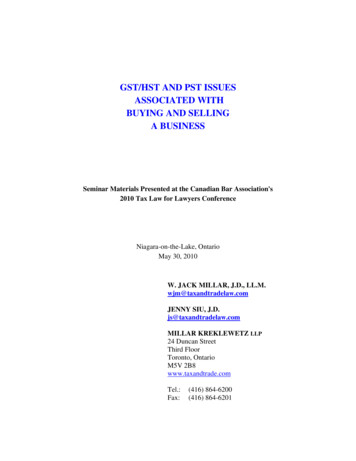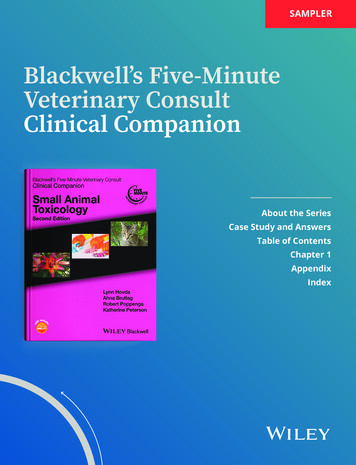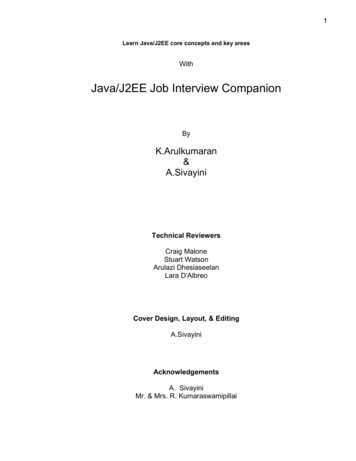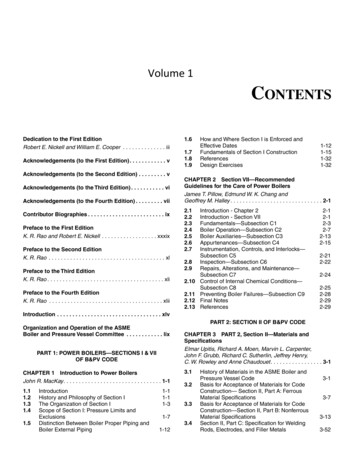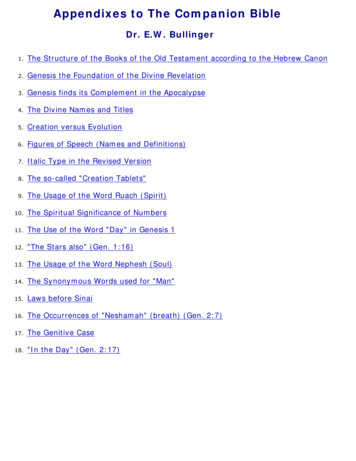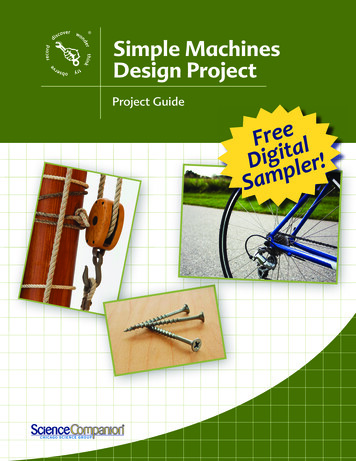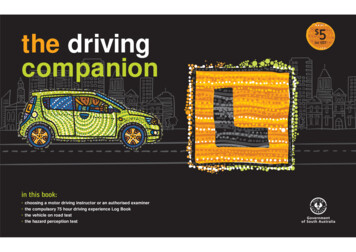
Transcription
the drivingcompanionin this book: hoosing a motor driving instructor or an authorised examinercthe compulsory 75 hour driving experience Log Bookthe vehicle on road testthe hazard perception test5 inc GST
the driving companion forclass ‘c’ vehiclesThe information contained within this publication has been preparedto help you become better informed about the provisions of the driverlicensing system. It should not be taken as a precise interpretation ofthe law. It does not set out to be complete or a substitute for thelegislation made by Parliament.Recent changes in laws may not be reflected in this publication.For further information please visit www.service.sa.gov.au.The Driving Companion can also be viewed on mylicence.sa.gov.auInformation on the relevant South Australian legislation may be obtainedfrom the following web site: www.legislation.sa.gov.auDiagrams are for illustrative purposes only and aren’t to scale.references The Driver’s HandbookAustralian Road RulesRoad Traffic ActMotor Vehicles Act (1959) and Regulations Government of South Australia.This work is licensed under a Creative Commons Attribution 3.0 Australia Licence.A summary of the licence terms is available deed.endoyouwanttoriskitall?Inexperience on the roads and risk-takingmean that drivers aged under 25 have upto three times the death and injury rate ofall drivers.So stay safe, be smart and avoid therisks. For more safer driving tips go tomylicence.sa.gov.auOFFICIALMR195 March 2021safer, smarter drivers start atmylicence.sa.gov.au
Before you driveLog BookThe Driving Companion2How to use your Log Book19Learner’s Permit conditions3Choosing your driving conditions19Who do you choose to instruct you?4Frequently asked questions19Choosing a Qualified Supervising Driver4Sample formChoosing a Motor Driving Instructor or an Authorised Examiner5Daytime forms22-31Enquiries and complaints6Night-time forms32-3321Declaration of driving hours34Graduated Licensing SchemeOverview7Vehicle On Road Test (VORT)The Hazard Perception Test8Option 1 : Vehicle On Road Test (VORT)35Practical driving options to progress to P1 Provisional Licence9Choosing this option offers the following35Conditions applying to the VORT36Government responsibilities in monitoring the licensing process37DrivingLearning to drive10Vehicle check11Competency Based Training & Assessment (CBT&A) courseSystem of Car Control12Option 2 : Competency Based Training & Assessment (CBT&A) course38Observation15Choosing this option has the following advantages38Rules of braking16Conditions applying to the CBT&A course39Steering16Training and assessment40Safe driving strategies17CBT&A Task index41Task forms42-74What happens next?Obtaining your Provisional Driver’s Licence - P1 & P275Provisional Licence conditions75Safer vehicles761
The Driving CompanionCongratulations on obtaining your Learner’s Permit. You have takenthe first steps towards embarking on a long driving career.This book is designed to inform you about the journey ahead and help youbecome a safe and capable driver. Read it thoroughly and keep it safe andsecure.Important - Before you begin to driveIt is your responsibility to operate a motor vehicle within the conditionsof your Learner’s Permit and the road rules. You are also responsible forensuring that anybody who supervises your driving is doing so legallyand that you accurately record your driving experience.The Driving Companion includes the following sections:Before you begin to drive, read and ensure that you understandthe following:Graduated Licensing Scheme Your licence conditionsThe Graduated Licensing Scheme is the process of providing new driverswith the skills and experience to safely progress to a full driver’s licence.It is explained in the next section. The road rules described in The Driver’s Handbook guide The requirements for your Qualified Supervising DriverBefore you drive Choosing a Motor Driving Instructor or an Authorised ExaminerDrivingLearning to drive takes a lot longer than most people think. As well ascontrolling your car, your must learn to make decisions and respond to what’shappening around you. The Driving section explains the skills and processrequired. - checking the vehicle, car control, observation, planning anddefensive strategies.Log BookAll Learner’s Permit holders must be accompanied by a QualifiedSupervising Driver whilst driving and must have at least 75 hours on-roaddriving experience and pass the Hazard Perception Test before obtaininga P1 Provisional Licence. The Log Book section is the official recordof your driving hours.Vehicle-On-Road Test (VORT) and Competency Based Training &Assessment (CBT&A) courseThere are two ways to qualify for your P1 Provisional Licence. You can eitherpass a practical driving test known as the Vehicle-On-Road Test (VORT) orundertake Competency Based Training & Assessment (CBT&A) course. Thisbook contains the competency standards for both options.2‘L’ Plates‘L’ plates must display a black letter ‘L’ printed on a yellow backgroundat the size dimensions specified below.
Learner’s Permit conditionsWho do you choose to instruct you?Learner’s permits are issued subject to conditions. If you breach acondition you will lose your learner’s permit and be disqualified fromdriving. This is in addition to any other penalty. The conditions are:To prepare yourself for the responsibility of driving a motor vehicle, it isrecommended that you obtain some professional tuition when learning todrive. you must not drive a motor vehicle with any concentration of alcoholin your blood or the presence of THC (the active component in cannabis),Methylamphetamine (also known as speed, ice or crystal meth) or MDMA(ecstasy) in your blood or oral salivaIdeally, training from a Motor Driving Instructor should occur together with lotsof practice with a friend or family member who meets the requirements for aQualified Supervising Driver. you must drive with a qualified supervising driver in the seat next to the driver when riding a motorcycle you must not carry a passenger on the motorcycle,or in a sidecar attached to the motorcycle, unless that person is a qualifiedsupervising driver you must not accumulate four or more demerit points during thelearner’s permit periodThe following laws also apply to the holder of a learner’s permit.If you breach any of these laws you may incur penalties such asfines, demerit points or loss of licence. you must only drive the class of motor vehicle stated on your licence you must display the correct size ‘L’ plates so that they are clearly visiblefrom the front and rear of the vehicle (rear only for motorcycle) you must carry your learner’s permit at all times whilst drivingChoosing a Qualified Supervising DriverA Qualified Supervising Driver must: have an unconditional licence authorising the person to drive a Class Cvehicle (or an equivalent foreign licence as approved by the Registrar ofMotor Vehicles) have held an unconditional/full licence for the last 2 years withoutdisqualification not hold a provisional or probationary licence or be subject to the conditionof “good behaviour” not have a blood alcohol reading of 0.05 or more, or the presence of THC(Cannabis), Methylamphetamine (Speed) or MDMA (Ecstasy) in their bloodor oral fluid. you must not drive over 100 km/h even if the local speed limit exceeds 100 km/hWhen you are learning to drive, the Qualified Supervising Driveraccompanying you is required to: you must not use any mobile phone function while driving includinghands-free mode, Bluetooth technology and loud speaker operation instruct you in the safe and efficient operation of the motor vehicle holders of a motorcycle learner’s permit who are under 25 years of ageand do not hold a P2 or full licence for another class of vehicle must not ridebetween midnight and 5am unless a qualified supervising rider is present asa passenger on the bike or in a sidecar attached to the bike (exemptions apply) holders of a motorcycle learner’s permit must not lane filterBefore you drive if you commit a speeding offence, you will also commit a breach of yourlearner’s permit conditions if you exceed the speed limit by 10 km/h or moreNote, only an Authorised Examiner can assess your driving ability by signingoff tasks for CBT&A or completing a VORT. instruct you in the correct application of the South Australian road rules be seated immediately alongside you at all times while you are drivingThis also applies to parking practice (even in car parks) ensure that the motor vehicle is registered and roadworthy comply with the licensing requirements (highlighted above)1233
You should also ensure that they have the following characteristics: patience and a calm approach to your learning the ability to guide you effectively in your practice.Being a Qualified Supervising Driver is an important role and this personmay face penalties for providing fraudulent information in your Log Book. Are you a Motor Driving Instructor and only able to provide training orare you an Authorised Examiner and able to train and assess? Are you able to assess and sign off tasks when I’m competent using theCBT&A option?If your Qualified Supervising Driver is later found to not have met therequirements to perform this role: When should I start driving lessons with an instructor? Does it have to be afterI have completed my 75 hours of driving? all of the log book entries relating to this person will be invalid and not counttowards your 15 and 75 hour requirements; How much do you charge per lesson and will you give a receipt?Please Note: Under Australian Consumer Law they must provide areceipt upon request or on any transaction over 75.00. if consequently you do not have enough hours, your licence will be declaredvoid (be cancelled);Before you driveThings you should ask your Motor DrivingInstructor or Authorised Examiner you will be required to surrender your licence; you will need to apply for the reissue of a Learner’s Permit.Note – A Qualified Supervising Driver with a Foreign Licence must: have a licence that is issued by a country recognised by South Australia; have held the licence for 2 or more years; Are there any hidden or extra costs, including Government charges?Please Note: A booking fee is charged by the Registrar to AuthorisedExaminer’s booking a VORT or final CBT&A assessment. Refer MotorVehicles Regulations 2010, Fees Schedule 1 Clause 29 for the current fee. How long is each lesson and will you record this time in my log book asdriving hours?Please Note: Qualified Supervising Drivers, Motor Driving Instructors andAuthorised Examiners must record driving hours including lessons in the log book. have a licence that is:an unconditional, full licence to drive a class C vehicle;current;written in English or have an English translation; What type of vehicle do you teach in, a manual or an automatic? be carried by the Qualified Supervising Driver Do I need to practice in between lessons? What are the homework expectations? How frequently do you recommend having lessons? Do you have a refund policy for cancellation of lessons? Are you able to conduct lessons that may start at home and finish at workor school and vice versa? Or any other location? What happens if I change my mind on the testing method or on using theexaminer I have chosen, how does this affect me?4
Choosing a Motor Driving Instructor or an Authorised ExaminerA person who receives a fee or any other reward (payment) for teaching you to drive must hold the appropriate Motor Driving instructor’s licence.Motor Driving Instructors and Authorised Examiners are required to clearly display their licence, either physical or digital (using the mySA GOV app) while teaching you to drive.Before choosing either a Motor Driving Instructor or an Authorised Examiner you need to check their licence and ensure that it is current and entitles them to conduct the trainingand/or assessment you require.If your Motor Driving Instructor or Authorised Examiner is not appropriately endorsed, all tasks undertaken by you will not be counted towards your licence.The time you drive with a Motor Driving Instructor, or Authorised Examiner, counts towards your required 75 hours of driving experience and must be entered in your Log Book.There are three types of Motor Driving Instructors or Authorised Examiners in South Australia.CBT&A AUTHORISEDEXAMINER (yellow flash)CBT&A & VORT AUTHORISEDEXAMINER (red flash)222255559999JANE CITIZENPETER DAVISCATHY JONESExp: 01/12/2029Exp: 01/12/2029Exp: 01/12/2029CBT&A - CARMotor Driving Instructor (no flash)CBT&A Authorised Examiner (yellow flash)CBT&A - CARVORT - CARVORT Authorised Examiner (red flash)Driving lessons and training onlyDriving lessons and trainingDriving lessons and trainingTime spent on your driving lessons countstowards your mandatory 75 hours of drivingTime spent on your driving lessons countstowards your mandatory 75 hours of drivingTime spent on your driving lessons countstowards your mandatory 75 hours of drivingAssess and sign off tasks in your book (CBT&A)Assess and sign off tasks in your book (CBT&A)Conduct a Vehicle On Road Test (VORT)Issue a Certificate of CompetencyIssue a Certificate of CompetencyIssue a Certificate of CompetencyConduct a Vehicle On Road Test (VORT)Conduct and assess a Vehicle On Road Test(VORT) but only if they haven’t provided trainingin preparation of itSign off CBT&A tasksBefore you driveMOTOR DRIVINGINSTRUCTOR (no flash)5
Enquiries and complaintsIf you require more information than contained within this guide or wish tolodge a complaint you should: If the complaint is in regards to the result of an assessment or test, discussthe issue first with your Motor Driving Instructor/Authorised Examiner;Before you drive If you have been unable to resolve the matter, if the complaint is in regardsto the way the assessment was conducted or about the conduct of the MotorDriving Instructor or Authorised Examiner, email: DIT.LicensingBookings@sa.gov.au; or via the DPTI complaints webpage https://dit.sa.gov.au/contact us/compliments and complaints;onecallortextcouldbefatalWhen lodging a complaint please provide the following information:o Your details - name, address, email and contact numbero Authorised Examiner or Motor Driving Instructor detailso An overview of what occurred including the date, time and locationo What attempts have been made to resolve this with your Motor DrivingInstructor or Authorised Examiner If your enquiry or complaint is in relation to the business practice of instructors,including refusal to issue receipts for payments made, please contact Consumerand Business Services on 13 18 82 or via their website www.cbs.sa.gov.au;You’re four times more likely to have a crashif you use your mobile phone while driving. If your enquiry or complaint relates to:o For discrimination refer to the Equal Opportunity Commission by calling8207 1977 or emailing eoc@agd.sa.gov.au;o Allegations of criminal behaviour refer to the South Australia Police bycalling 131 444; oro Allegations of corruption, misconduct and malpractice and IndependentCommissioner Against Corruption (ICAC)/Office of Public Integrity viaphone 8207 1777 or email admin@opi.sa.gov.auThat’s why L and P1 drivers are banned fromusing any mobile phone function when driving,including text messaging, hands free mode,loudspeaker operation or GPS. Get used to turningoff your phone before you get in your car.If you really need to check a message, pull overand turn the engine off. It’s a small thing that couldsave your life, and the lives of your passengers.So stay safe, be smart and don’t use a mobile phonewhile you’re driving. For more safer driving tips to tomylicence.sa.gov.ausafer, smarter drivers start at6mylicence.sa.gov.au
Unfortunately statistics show that drivers aged 16 to 24 years are almost twice aslikely to be involved in a serious or fatal road crash.But research has also found that strengthening the driving experiences andsupervision of new drivers through graduated licensing schemes can lead tosignificant reductions in crashes both before and after obtaining a driver’s licence.The Graduated Licensing Scheme is the process of obtaining a full driver’s licence– a gradual process which involves: at least 75 hours of supervised driving during the learner’s permit phase(not required for learner motorcycle riders) a compulsory hazard perception test to progress from L to P1 a two-stage provisional licence (P1 and P2)LPLPlatesPP2NOT DISPLAYEDON VEHICLE 16 years or older pass theory testLEARNER’S PERMIT (BIKE class must pass basic Rider Safe)P1PROVISIONALLICENCE 17 years or older pass hazard perception test if you are under the age of 25 you must hold your learner’spermit for at least 12 months. if you are aged 25 or over you must hold yourlearner’s permit for at least 6 months. complete 75 hours (includes minimum 15 hours at night) ofsupervised driving pass Vehicle On Road Test (VORT) or Competency BasedTraining & Assessment (CBT&A) course (BIKE class must pass advanced Rider Safe course) 18 years or older must have held a P1 licence for 12 monthsPROVISIONALLICENCEFullLicence 20 years or older have held a P2 licence for 2 yearsGraduated Licensing SchemeGraduated Licensing Scheme Overview7
The Hazard Perception Test (HPT)The HPT is based on the driving situations that lead to the four most commoncrash types of South Australian provisional drivers.It involves a touch-screen computer-based test that measures your ability torecognise potentially dangerous situations on the road and react appropriately.You must pass the HPT to progress from a Learner’s Permit to a P1 licence.The HPT must be booked and undertaken at a Service SA customer service centre.Graduated Licensing SchemeIf you live more than 100 kilometres (as the crow flies) from a place wherethe test is conducted, or on Kangaroo Island, you are exempt from havingto sit the test.Why the Hazard Perception Test?The aim of the HPT is to confirm that learner drivers have enough hazardperception skills to “graduate” to the P1 licence. Research shows that driverswith poor hazard perception skills usually have more crashes.Research also shows that screen-based hazard perception tests can detectdrivers with a higher risk of crash involvement.Crash patterns of provisional driversThe four most common crash types for provisional driversThe majority of all South Australian provisional driver crashes fall withinonly four crash types:Collisions where at leastone vehicle is turning right.Running off the road and hitting anobject, such as a tree, a pole or aparked vehicle.Why are provisional drivers involved in high numbers of crashes?The high involvement of provisional drivers in crashes seems to be partly due toinexperience because driving is a new skill. When we start something new wetend to make mistakes and are not be as skilful as those with lots of experience.However, new drivers also sometimes do things that can increase their risk ofcrash involvement. These include: travelling too closely behind other vehicles driving too fast for the conditions not looking far enough ahead when driving choosing gaps that are too small when making turns,crossing intersections or overtaking. driving with drugs and alcohol in their system being distracted by mobile phones running red lights.Avoiding crashesIt is important to know what driving situations are most dangerous for you.You can then identify the skills you need to practise so you can handle thesesituations safely. Research shows that one of the most important of these skillsis good hazard perception.Colliding with the rear ofanother vehicle.Colliding at right angles.This is why the Hazard Perception Test has been introduced in South Australia.For more information and to practise the Hazard Perception Testplea
.the vehicle on road test .the hazard perception test 5 inc GST. Inexperience on the roads and risk-taking mean that drivers aged under 25 have up to three times the death and injury rate of all drivers. So stay safe, be smart and avoid the ris

